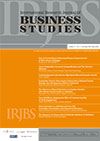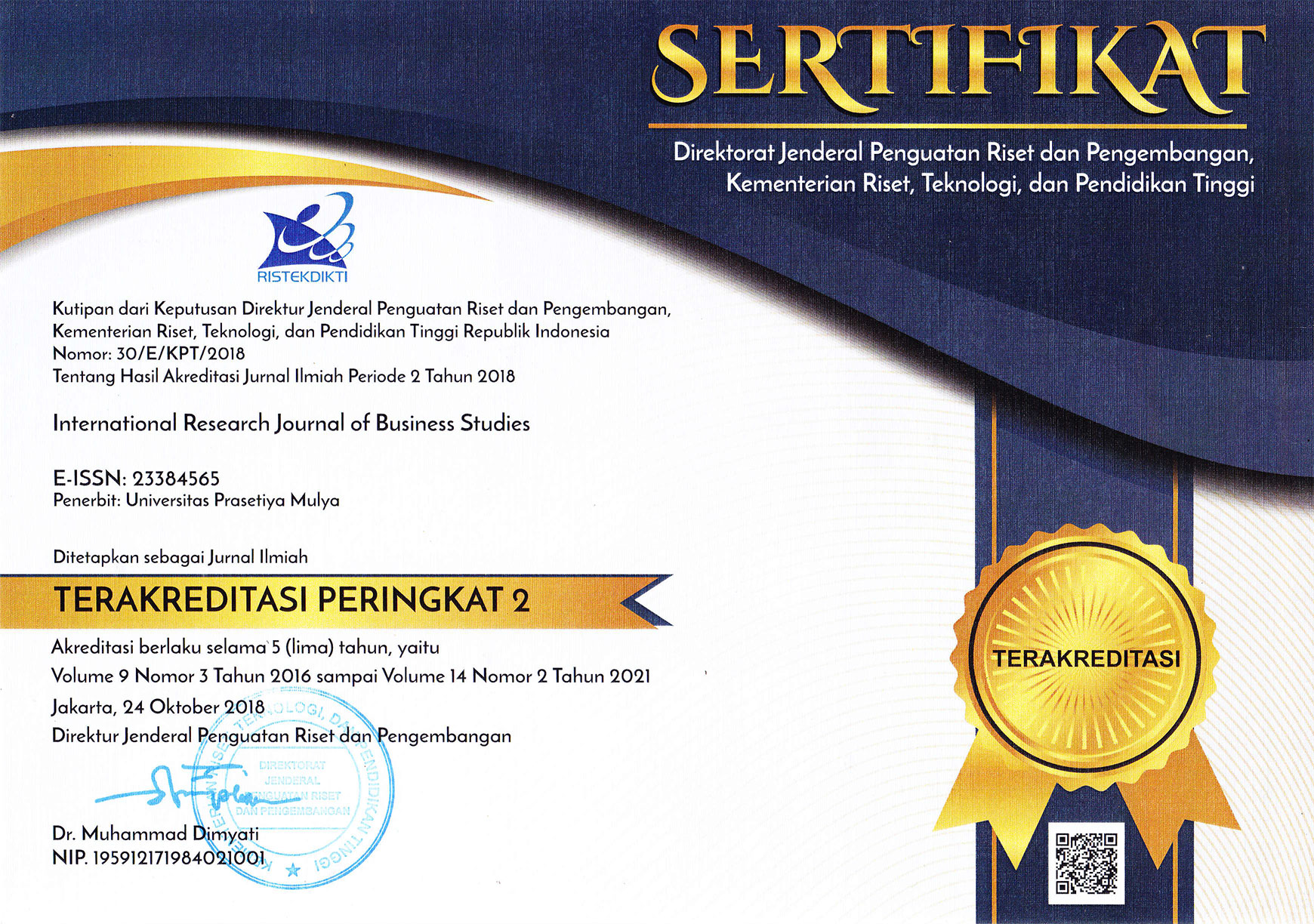Competitive Advantages of Small Medium Industry on the Islands in Indonesian Context
DOI:
https://doi.org/10.21632/irjbs.11.1.9-19Keywords:
competitiveadvantage, small medium industry, islands, Indonesia, governmentAbstract
Indonesian Law No.3/2014 regarding Industry requires both Central and Local Governments to realize the competitiveness of small and medium industries. However, the fact that the condition of each region is not similar becomes a main problem. It is because Indonesia is an archipelagic country. The competitiveness index of Asia Competitiveness Institute 2015 indicates that islands provinces, such as Kepulauan Bangka Belitung, Nusa Tenggara Barat, Nusa Tenggara Timur, Sulawesi Utara, Maluku, Maluku Utara, Sulawesi Tenggara, need specific development strategies. They cannot be equated with the mainlands, such as Java and Sumatera, because their competitiveness rank is very low. A review of literature on the competitiveness of islands entrepreneurs shows that from the 4 (four) schools of thought in competitive advantage, only few researchers have pertained on the knowledge based on the schools of thought. Therefore, this could be a future research opportunity.
References
A.B., Y. (1995). Critical success factors for small business: perceptions of South Pacific entrepreneurs. Journal of Small Business Management, 33(2), 68–73.
A.B., Y. (1998). Small business development and survival in the south pacific: Barriers and strategic responses. Journal of Entrepreneurship, 7(1), 49–65.
Aubert, J., & Chen, D. H. C. (2008). The island factor as a growth booster for nations: a mental advantage econometrically revealed. Journal of Intellectual Capital, 9(2), 178–205.
Baldacchino, G. (1998). The other way round: manufacturing as an extension of services in small island states. Asia Pacific Viewpoint, 39(3), 267–279.
Baldacchino, G. (2000). An exceptional success manufacturing firm in a small island country. The Journal of Pasific Studies, 23(1), 27–47.
Baldacchino, G. (2002). A Taste of Small-Island Success: A Case from Prince Edward Island. Journal of Small Business Management, 40(3), 254–259.
Baldacchino, G. (2005a). Island entrepreneurs: Insights from exceptionall successful knowledge-driven SMEs from 5 European island territories. Journal of Enterprising Culture, 13(2), 145–170.
Baldacchino, G. (2005b). Successful Small-Scale Manufacturing: a Comparative Assessment Across Five European Island Regions *. Bank of Valletta Review, (31), 17–31.
Baldacchino, G. (2010). Islands and beers: Toasting a discriminatory approach to small island manufacturing. Asia Pacific Viewpoint, 51(1), 61–72.
BPS. (2015). Penduduk Indonesia Hasil Survei Penduduk Antar Sensus 2015.
Cater, T. (2003). The relevance of four school of thought on the sources of a firm’s competitive advantage: a case of slovenian firms. Economic and Business Review, 5(4), 309–332.
Cater, T. (2004). The relevance of the knowledge-based school of thought on the sources of a firm’s competitive advantage. Management, 9(1), 1–26.
Cromie, S., Dunn, B., Sproull, A., & Chalmers, D. (2001). Small firms with a family focus in the Scottish Highlands and Islands. Irish Journal of Management, 22, 45–66.
Davenport, T. H., & Prusak, L. (1998). Working Knowledge: How Organizations Manage What They Know. Knowledge Creation Diffusion Utilization, 309. https://doi.org/10.1109/EMR.2003.1267012
Gungaphul, M., & Boolaky, M. (2009). Entrepreneurship and marketing: an exploratory study in Mauritius. Journal of Chinese Entrepreneurship, 1(3), 209–226.
Jaca, C., Viles, E., Paipa-Galeano, L., Santos, J., & Mateo, R. (2014). Learning 5S principles from Japanese best practitioners: Case studies of five manufacturing companies. International Journal of Production Research, 52(15), 4574–4586.
Makadok, R. (2001). Toward a synthesis of the resource based and dynamic capability views of rent creation. Strategic Management Journal, 22(5), 387–401.
María García-Pérez, A., Yanes-Estévez, V., Ramón Oreja-Rodríguez, J., & González-Dávila, E. (2014). Strategic positioning and strategic types of small firms. Journal of Small Business and Enterprise Development, 21(3), 431–449.
Mike Danson and Kathryn Burnett. (2014). Exploring Rural Enterprise: New Perspectives on Research, Policy & Practice, 4.
Naidu, S., & Chand, A. (2012). A comparative study of the financial problems faced by micro, small and medium enterprises in the manufacturing sector of Fiji and Tonga. International Journal of Emerging Markets, 7(3), 245–262.
O’Shannassy, T. (2008). Sustainable competitive advantage or temporary competitive advantage. Journal of Strategy and Management, 1(2), 168–180.
Sambajee, P., & Dhomun, M. Z. A. (2015). Government and SMEs in the Maldives and Mauritius. International Journal of Entrepreneurial Behavior & Research, 21(6), 778–795.
Scott, N., Denize, S., Sloan, T., & Sydney, W. (2005). Internationally competitive firms in small island developing states: Why do they succeed? Nick Scott, Sara Denize, Terry Sloan, University of Western Sydney, 1–7.
Singh, G., Pathak, R. D., & Naz, R. (2010). Issues faced by SMEs in the internationalization process: results from Fiji and Samoa. International Journal of Emerging Markets, 5(2), 153–182.
Singh, T., Pathak, R., & Kazmi, a. (2007). An empirical study of small business organizations in Fiji using a competency-based framework. South Asian Journal of Management, 14(2), 7–35.
Solem, M. P. S. and O. (1988). Factors for Success in Small Manufacturing Firms. Journal of Small Business Management, 26(1), 6.
Švárová, M., & Vrchota, J. (2014). Influence of Competitive Advantage on Formulation Business Strategy. Procedia Economics and Finance, 12(March), 687–694.
Than, K.G., Amri, M., Merdikawati, N & Ahmad, N (2017): 2015 Annual Competitiveness Analysis and Development Strategies for Indonesian Provinces, Singapore: World Scientific Publishing
Ünlücan, D. (2010). Characteristics of SMEs in North Cyprus: A small island. Problems and Perspectives in Management, 8(3), 139–147.
van Gelder, J.-L., de Vries, R. E., Frese, M., & Goutbeek, J.-P. (2007). Failed and Operational Business Owners. Journal of Small Business Management, 45(3), 388–400.
Wang, M.-H., & Yang, T.-Y. (2016). Investigating the success of knowledge management: An empirical study of small- and medium-sized enterprises. Asia Pacific Management Review, 21(2), 79–91.
References from website:
Nasional kontan. (2017, March 2). Islands provinces in Indonesia, retrieved from Source:http://nasional.kontan.co.id/news/provinsi-kepulauan-akan-terima-dau-lebih-besar; accessed on: Thursday, March 02, 2017, 8:39:09 AM
Downloads
Submitted
Published
How to Cite
Issue
Section
License
Copyright (c) 2018 Muslim El Hakim Kurniawan, Gatot Yudoko, Mursyid Hasan Basri

This work is licensed under a Creative Commons Attribution-ShareAlike 4.0 International License.
Journal Author(s) Rights
For IRJBS to publish and disseminate research articles, we need publishing rights (transferred from the author(s) to the publisher). This is determined by a publishing agreement between the Author(s) and IRJBS. This agreement deals with the transfer or license of the copyright of publishing to IRJBS, while Authors still retain significant rights to use and share their own published articles. IRJBS supports the need for authors to share, disseminate and maximize the impact of their research and these rights, in any databases.
As a journal Author, you have rights to many uses of your article, including use by your employing institute or company. These Author rights can be exercised without the need to obtain specific permission. Authors publishing in IRJBS journals have comprehensive rights to use their works for teaching and scholarly purposes without needing to seek permission, including:
- use for classroom teaching by Author or Author's institution and presentation at a meeting or conference and distributing copies to attendees;
- use for internal training by the author's company;
- distribution to colleagues for their research use;
- use in a subsequent compilation of the author's works;
- inclusion in a thesis or dissertation;
- reuse of portions or extracts from the article in other works (with full acknowledgment of the final article);
- preparation of derivative works (other than commercial purposes) (with full acknowledgment of the final article);
- voluntary posting on open websites operated by the author or the author’s institution for scholarly purposes,
(But it should follow the open access license of Creative Common CC-by-SA License).
Authors/Readers/Third Parties can copy and redistribute the material in any medium or format, as well as remix, transform, and build upon the material for any purpose, even commercially. Still, they must give appropriate credit (the name of the creator and attribution parties (authors' detail information), a copyright notice, an open access license notice, a disclaimer notice, and a link to the material), provide a link to the license, and indicate if changes were made (Publisher indicates the modification of the material (if any) and retain an indication of previous modifications.
Authors/Readers/Third Parties can read, print and download, redistribute or republish the article (e.g. display in a repository), translate the article, download for text and data mining purposes, reuse portions or extracts from the article in other works, sell or re-use for commercial purposes, remix, transform, or build upon the material, they must distribute their contributions under the same license as the original Creative Commons Attribution-ShareAlike (CC BY-SA).
This work is licensed under a Creative Commons Attribution-ShareAlike 4.0 International License.








